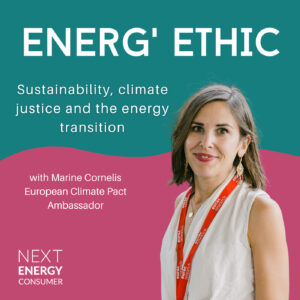Episode 57 of Energ’Ethic is Here!
In this captivating new episode of Energ’Ethic, we tackle one of the most pressing questions in the renewable energy space: how much land is really needed to power Europe with 100% renewables?
Join Marine Cornelis as she sits down with Cosimo Tansini from the European Environmental Bureau (EEB), who shares his expert insights on land use, biodiversity, and the Paris Agreement Compatible (PAC) Scenario, a civil society-led roadmap for achieving a fully renewable energy system in the EU by 2040.
Cosimo opens the conversation by explaining that the PAC scenario “results in climate neutrality by 2040,” and that the shift to 100% renewable energy “requires about 2.2% of Europe’s land—roughly the size of Croatia.”
But how does this compare to other land uses?
Cosimo brilliantly breaks it down, pointing out that “almost triple the land used for renewable energy today is used for fodder crops, which aren’t even for food production but livestock.” This comparison helps put the renewable land requirements into perspective.
Land use isn’t the only thing on the table. Cosimo and Marine explore how renewable energy projects can drive social cohesion and economic regeneration, especially in rural areas. Cosimo highlights the power of energy communities, where local citizens can co-own their energy infrastructure, noting that “renewables hold the key because they come with the possibility of a different business model—co-owned by the citizens, saving massively on energy bills.”
<iframe name="Ausha Podcast Player" frameborder="0" loading="lazy" id="ausha-dTjX" height="220" style="border: none; width:100%; height:220px" src="https://player.ausha.co/?showId=e14Y3fmkjrnW&color=%23bb576e&podcastId=lDzektz5g1DX&v=3&playerId=ausha-dTjX"></iframe><script src="https://player.ausha.co/ausha-player.js"></script>
But achieving this balance between renewable energy deployment and protecting biodiversity is key. Cosimo emphasizes that the siting of renewable projects must be done carefully, utilizing tools like “sensitivity mapping” developed by NGOs like BirdLife and the EU’s Joint Research Centre to identify low-conflict areas. As he puts it, “We not only have renewables to install, but we also have nature to protect.”
The episode also dives into the PAC scenario’s holistic approach, which includes reducing energy consumption through efficiency and sufficiency. Marine and Cosimo reflect on how we can “make virtuous choices possible” in our daily lives, from expanding city cycling systems to rethinking how much energy we need.
By the end of the episode, you will walk away with a deeper understanding of how renewable energy can be a driver for social and environmental good, but only when it’s done right.
Cosimo reminds us that “it’s about leaving the right space for nature while scaling up renewables,” and that proper planning and inclusive community dialogue are essential.
Key Takeaways from Episode 57:
- Land Use Comparisons: Renewable energy will take up about 2.2% of Europe’s land, but that’s small compared to other land uses like fodder crops.
- Energy Communities: Local ownership of renewable projects offers a way to reduce energy bills and benefit communities.
- Balancing Nature & Renewables: Strategic planning, using tools like sensitivity mapping, is critical to ensure renewable projects protect biodiversity.
Tune in to this episode of Energ’Ethic to learn more about how land use, renewable energy, and biodiversity intersect, and how we can make the energy transition work for people and the planet.
Big thanks to the European Environmental Bureau for making this conversation possible.



